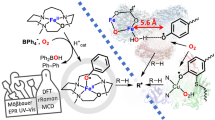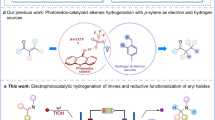Abstract
MUCH attention has been given to electron transfer between metal ions through organic ligands, particularly the chromium(II)–cobalt(III) reduction1–5. Experiments have shown that conjugated dicarboxy ligands such as fumarate may provide two paths for the electron transfer: the ligand may be attacked by the reductant at either of the two COO groups. Attack at the remote carboxyl is evidenced by both an acid-independent and an acid-dependent term in the rate laws, while attack at the carboxyl group co-ordinated to the oxidant is acid-independent. The role of the proton in the acid-dependent reaction is to increase conjugation between the remote carboxyl and the cobalt(III) centre, for example:  and an examination of the induced ester hydrolysis in experiments with vanadium(II) and half-ester complexes6 has shown that the remote attack involves bond formation between the reductant and the carbonyl oxygen of the carboxyl group:
and an examination of the induced ester hydrolysis in experiments with vanadium(II) and half-ester complexes6 has shown that the remote attack involves bond formation between the reductant and the carbonyl oxygen of the carboxyl group: 
This is a preview of subscription content, access via your institution
Access options
Subscribe to this journal
Receive 51 print issues and online access
$199.00 per year
only $3.90 per issue
Buy this article
- Purchase on Springer Link
- Instant access to full article PDF
Prices may be subject to local taxes which are calculated during checkout
Similar content being viewed by others
References
Taube, H., J. Amer. Chem. Soc., 77, 4481 (1955).
Fraser, R. T. M., Sebera, D. K., and Taube, H., J. Amer. Chem. Soc., 81, 2906 (1959).
Fraser, R. T. M., J. Amer. Chem. Soc., 83, 564 (1961).
Sebera, D. K., and Taube, H., J. Amer. Chem. Soc., 83, 1785 (1961).
Fraser, R. T. M., Inorg. Chem., 3, 255 (1964).
Fraser, R. T. M., and Taube, H., J. Amer. Chem. Soc., 81, 5514 (1959).
Sen, D. N., Mizushima, S., Curran, C., and Ouagliano, J. V., J. Amer. Chem. Soc., 77, 211 (1955).
Drouin, M., Mathieu, J., and Poulet, H., J. Chim. Phys., 58, 322 (1961).
Bertin, E. P., Penland, R. B., Mizushima, S., Curran, C., and Ouagliano, J. V., J. Amer. Chem. Soc., 81, 3818 (1959).
Hunt, J. P., Rutenberg, A. C., and Taube, H., J. Amer. Chem. Soc., 74, 268 (1952).
Bunton, C. A., and Llewellyn, D. R., J. Chem. Soc., 1692 (1953).
Author information
Authors and Affiliations
Rights and permissions
About this article
Cite this article
FRASER, R. Point of Reductant Attack in Electron Transfer through Carboxylate Mediators. Nature 202, 691–692 (1964). https://doi.org/10.1038/202691a0
Issue Date:
DOI: https://doi.org/10.1038/202691a0
Comments
By submitting a comment you agree to abide by our Terms and Community Guidelines. If you find something abusive or that does not comply with our terms or guidelines please flag it as inappropriate.



